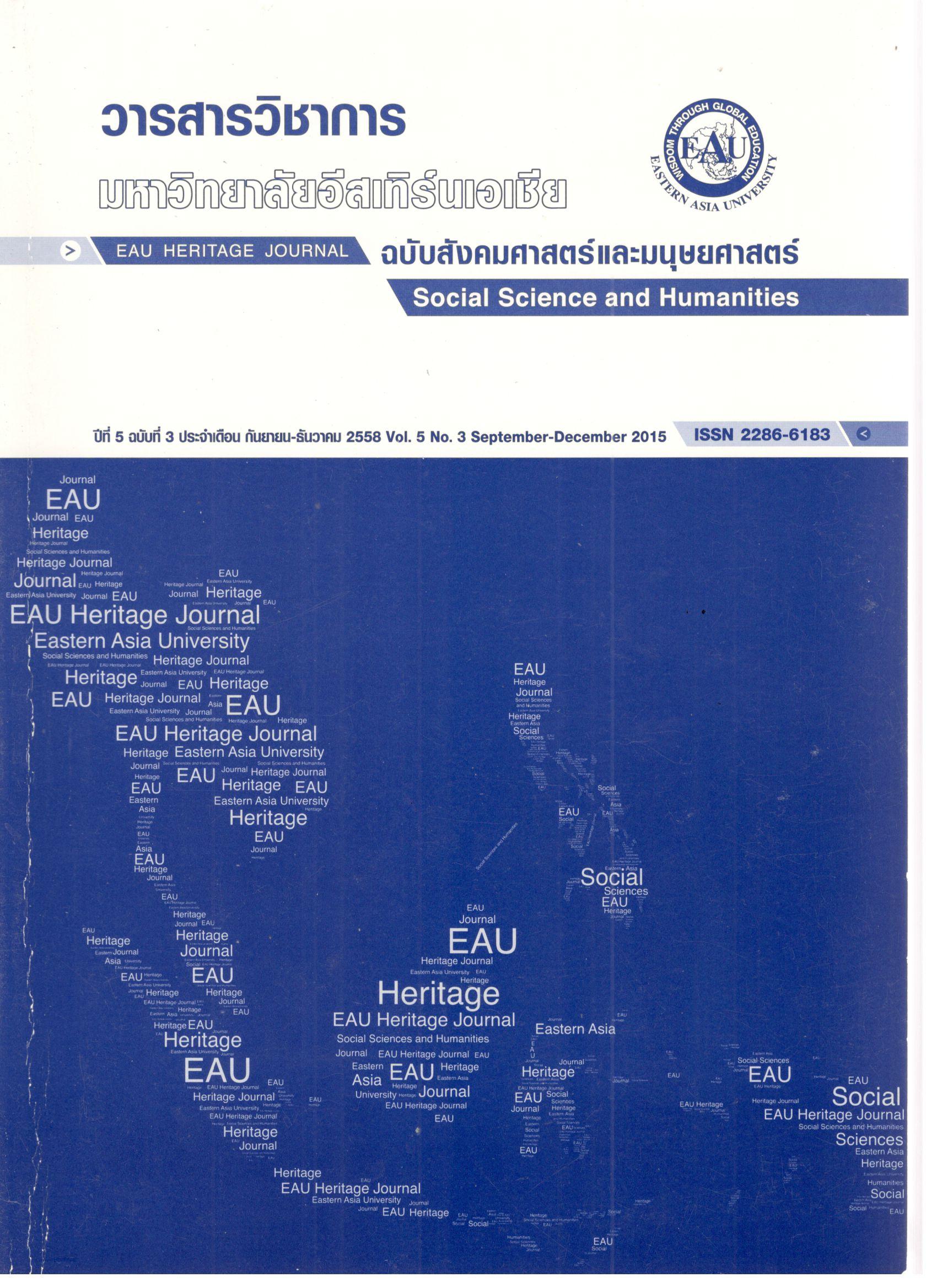การวิเคราะห์สมรรถนะเพื่อการฝึกอบรมและพัฒนาผู้จัดการท่าอากาศยานนานาชาติ
Keywords:
สมรรถนะ, การฝึกอบรมและพัฒนา, ผู้จัดการท่าอากาศยาน, ท่าอากาศยานนานาชาติ, ตลาดการบินเดียวAbstract
บทความวิจัยเรื่องนี้มีวัตถุประสงค์ (1) เพื่อศึกษาบทบาทหน้าที่ผู้จัดการท่าอากาศยานนานาชาติในตลาดการบินเดียวอาเซียน (2) เพื่อกำหนดรูปแบบสมรรถนะเพื่อการฝึกอบรมและพัฒนาที่สำคัญและจำเป็นต่อการปฏิบัติหน้าที่ผู้จัดการท่าอากาศยานนานาชาติในตลาดการบินเดียวอาเซียน (3) เพื่อตรวจสอบรูปแบบสมรรถนะเพื่อการฝึกอบรมและพัฒนาที่มีความเหมาะสม ครอบคลุมสมรรถนะที่สำคัญและจำเป็นต่อการปฏิบัติหน้าที่ผู้จัดการท่าอากาศยานนานาชาติในตลาดการบินเดียวอาเซียน กลุ่มตัวอย่างได้แก่ ผู้เชี่ยวชาญการบริหารท่าอากาศยานนานาชาติในตลาดการบินเดียวอาเซียน ผู้เชี่ยวชาญในอุตสาหกรรมการบิน ผู้ทรงคุณวุฒิด้านการบริหารการศึกษาและผู้นำการเปลี่ยนแปลง จำนวน 40 คน เครื่องมือที่ใช้ในการศึกษาเป็นแบบสัมภาษณ์กึ่งโครงสร้างและแบบสอบถามเกี่ยวกับสมรรถนะหลักและสมรรถนะในงาน ผู้จัดการท่าอากาศยานนานาชาติในตลาดการบินเดียวอาเซียน ผลการวิจัยพบว่า ผู้จัดการท่าอากาศยานนานาชาติในตลาดการบินเดียวอาเซียน มีบทบาทหน้าที่ 4 ด้าน สมรรถนะหลัก 5 รายการ สมรรถนะในงาน 24 รายการ ผลการตรวจสอบรูปแบบสมรรถนะเพื่อการฝึกอบรมและพัฒนา มีความเหมาะสม ครอบคลุม สมรรถนะที่สำคัญและจำเป็นต่อการปฏิบัติหน้าที่ผู้จัดการท่าอากาศยานนานาชาติในตลาดการบินเดียวอาเซียน ในระดับมากที่สุดทุกสมรรถนะ
References
กรมการบินพลเรือน. (2556). รายการกฎหมาย. ค้นเมื่อ 3 สิงหาคม 2557, จาก http://www.aviation.go.th/th/gov_law/
นณริฏ พิศลยบุตร. (2558, มีนาคม 3). TDRI แนะรัฐวางหมากให้ชัดก่อนเข้าสู่ AEC. Retrieved from สถาบันวิจัยเพื่อการพัฒนาประเทศไทย: http://tdri.or.th/tdri-insight/tdri-recommend-government-to-clear-before-aec/
ฐานเศรษฐกิจออนไลน์. (2555, มิถุนายน 1). ฐานเศรษฐกิจออนไลน์,
ธีรพันธ์ ชัยมงคลโรจน์. (2556). ระบบสมรรถนะมหาวิทยาลัยกรุงเทพ. กรุงเทพฯ: มหาวิทยาลัยกรุงเทพ.
จาก: http://www. personneloffice.bu.ac.th/HR/Documents/.../BU_Competency.pdf
บริษัทแมเนจเมนท์โซลูชั่นส์อินเตอร์เนชั่นแนล จำกัด. (2547). รายงานฉบับสมบูรณ์งานจัดทำระบบพัฒนาภาวะผู้นำ. กรุงเทพฯ: ท่าอากาศยานไทยจำกัด (มหาชน).
ผู้จัดการออนไลน์. (2554). ประชุมท่าอากาศยานอาเซียนเน้นสิ่งแวดล้อม. ผู้จัดการออนไลน์.
พาราฮาแลด, ซี.เค., และ แฮมเมล, แกรี่. (2547). ความสามารถหลักขององค์กร. (ฐิตินันท์ อิฐรัตน์, ผู้แปล). กรุงเทพฯ: เอ็กซเปอร์เน็ท.
ศูนย์อำนวยการพลังแผ่นดินเอาชนะยาเสพติดแห่งชาติ. (2555). Retrieved ค้นจาก ศูนย์อำนวยการพลังแผ่นดินเอาชนะยาเสพติดแห่งชาติ: http://nccde.oncb.go.th/
สถาบันนานาชาติเพื่อเอเชียแปซิฟิคศึกษา มหาวิทยาลัยกรุงเทพ. (2553). รายงานฉบับสมบูรณ์เรื่องการเปิดเสรี โลจิสติกส์อาเซียน: โอกาสผลกระทบและการปรับตัวของผู้ประกอบการไทย.กรุงเทพฯ: กรมเจรจาการค้าระหว่างประเทศ.
สมชาย เธียรอนันท์. (2552, มิถุนายน 2). วิทยุการบินเล็งเป็นผู้นำการขนส่งทางอากาศ. ไทยรัฐ. หน้า 19-21.
สำนักงานข้าราชการพลเรือน . (2548). เอกสารประกอบการสัมมนา สมรรถนะของข้าราชการ, ค้นเมื่อ 20 ธันวาคม
, จากwww.ocsc.go.th/ocsc/th/uploads/File/competency.pdf.
สำนักงานคณะกรรมการข้าราชการพลเรือน. (2553). คู่มือสมรรถนะของข้าราชการไทย. กรุงเทพฯ: ผู้แต่ง
สำนักงานคณะกรรมการข้าราชการพลเรือน.
สำนักงานข้าราชการพลเรือน. (2557). การพัฒนาระบบสมรรถนะ. ค้นจากhttp://www.ocsc.go.th/ocsc/th/index.php?option=com_content&view=article&id=258&Itemid=252
สุกัญญา รัศมีธรรมโชติ. (2550). การจัดการทรัพยากรมนุษย์ด้วย Competency based HRM. กรุงเทพฯ:
อมรินทร์พริ้นติ้งแอนด์บันลิชชิ่ง จำกัด (มหาชน).
Abdul, A. Z. (2007). Managing talent: The Malasia airports way. Jeju, Korea: The Malasia Airports.
ASEAN. (2009). The Implementation Framework of the ASEAN Single Aviation Market (ASAM), Phnom Penh, Cambodia, 16 December 2011. Retrieved from http://www.aseansec.org/19867.htm
Balboa, J. D., & Wignaraja, G. (2014). ASEAN economic community 2015: What is next? Retrieved from http://www.asiapathways-adbi.org/2014/12/asean-economic-community-2015-what-is-next/
Boyatzis, R. E. (1982). The ompetent manager: A model for effective performance (The President Association ed.). New York, NY: John Wiley & Sons.
Campion, M. A., Fink, A. A., Ruggeberg, B. J., Carr, L., Phillips, G. M., & Odman, R. B. (2011). Doing competencies well: Best practices in competency modelling. Personnel Philosophy(64), 225-262.
Dallas/Fort Worth International Airport. (2011). Dallas/Fort Worth International Airport AMAC – Airport Business Diversity Conference. Dallas: Dallas/Fort Worth International Airport.
Griffith, J. (1994). Aiport management issues. Management Development Review, 7(2), 16.
Hewlett-Packard Development Company, L.P. (2011). 2011 Annual report. Delaware: Hewlett-Packard Development Company, L.P.
Hiatt, J. M., & Creasey, T. J. (2003). Change management: The people side of change. Loveland, Colorado: Prosci
Research.
Inamete, U. B. (1988). Key elements in manageing airports: The policy environment and increasing efficiency. International Jounal of Public Sector Management, 6(5).
LaRocca, M. (2011). Career and competency pathing: The competency modelling approach. from http://edweb.sdsu/people/arossett/pie/interventions/career_l.htm
Marshall, P. (1992). Why are some people more successful than others? In N. Boulter, M. M. Dalziel, & J. Hill, Achieving the perfect fit, How to win with the right people in the right Jobs (p. 133). Houston, Texas: Gulf.
McClelland, D. C. (1973). Testing for competence rather than for “Intelligence”. American Psychologist, (Jan),
-14.
McDonough, W. (2010). Forward. In B. Doppolt, Leading change toward sustainability A change management guide for business, Governent and Civil Society (p. 296). Sheffield, UK: Greenleaf Publishing Limited.
Naquin, S. S., & Holton, E. F. (2003). Redefining state government leadership and management development: A process for competency-based development. Public Personnel Development, 32(1), 23.
Neer, C. (2006). Cahange management enhance the ability to survive. Norderstedt Germany: GRIN Verlag.
Ryan, G., Spencer, L. M., & Bernhard, U. (2012). Development and validation of a customized competency-based questionnaire: Linking social, emotional, and cognitive competencies to business profitability. Cross Cultural Management, 19(1), 90-103.
Spiro, J. (2011). Leading Change Step-By-Step Tatics, Tools, and Tales. Sanfrancisco, CA: John Wileys & Sons.
United States Office of Personnel Management. (2008). The guide to implementing the federal competency assessment tool - management. United States Office of personnel Management.
White, R. W. (1959). Motivation reconsidered: The concept of competence. Psychological Review, 66(5), 297-333.
Vugotich, G. (2011). Ten steps to successful change management. Danvers, MA: The American Society for Training & Development.





